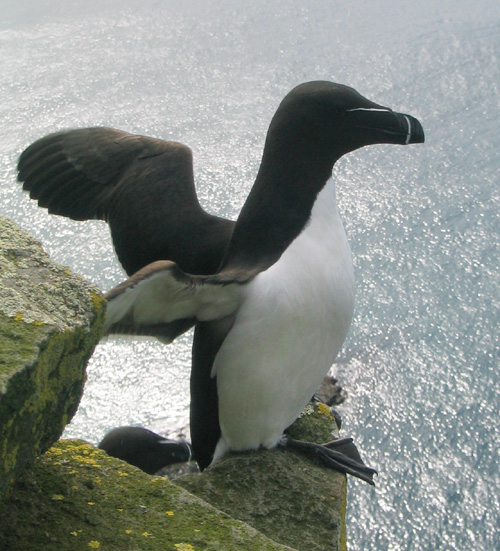Razorbill (Alca torda) - Wiki Razorbill
From Wikipedia, the free encyclopedia
[Photo] Razorbill at bird cliff in Westfjords, Iceland. Photo taken by Gsd97jks (http://en.wikipedia.org/wiki/User:Gsd97jks). License: public domain.
The Razorbill, Alca torda, is a large alcid, 38-43 cm in length, with a 60-69 cm wingspan. It is the only member of the genus Alca.
Adult birds are black on their upperparts and white on the breast and belly. The thick black bill has a blunt end. The tail is pointed and longer than that of a Murre. In winter, the black face becomes white.
Their breeding habitat is islands, rocky shores and cliffs on northern Atlantic coasts, in eastern North America as far south as Maine, and in western Europe from northwestern Russia to northern France. They usually nest in colonies and lay their eggs on bare rock or ground.
North American birds migrate offshore and south, ranging from the Grand Banks of Newfoundland to New England. Eurasian birds also winter at sea, with some moving south as far as the western Mediterranean.
These birds forage for food by swimming underwater. They mainly eat fish, like sandeels, herring and capelin, also some crustaceans and marine worms.
Example occurrences
Locations which are known to support Razorbill populations:
Staple Island, Outer Farne Islands, Western and North Eastern British Isles - especially in breeding season from May to mid-July. Ref with map: RSPB.org.uk
Gr??msey, Iceland (66°N lat)
Evolution and prehistoric species
While the Razorbill is the only living species, the genus Alca had a much higher diversity in the Pliocene. As far as is known, the genus seems to have evolved in the western North Atlantic or the present-day Caribbean, which its ancestors would have reached through the still-open Isthmus of Panama during the Miocene (B??dard, 1985). A number of fossil forms have been found:
Alca "antiqua" (Late Miocene/Early Pliocene of Lee Creek Mine, USA)
Alca sp. (Late Miocene/Early Pliocene of Lee Creek Mine, USA) - possibly A. stewarti
Alca stewarti (Early Pliocene of Belgium)
Alca ausonia (Yorktown Early Pliocene of Lee Creek Mine, USA - Middle Pliocene of Italy)
Alca sp. (Puerto de Mazarr??n Pliocene of El Alamillo, Spain) - may be A. antiqua or A. ausonia
http://en.wikipedia.org/wiki/Razorbill
| The text in this page is based on the copyrighted Wikipedia article shown in above URL. It is used under the GNU Free Documentation License. You may redistribute it, verbatim or modified, providing that you comply with the terms of the GFDL. |
